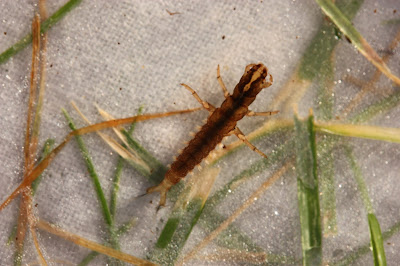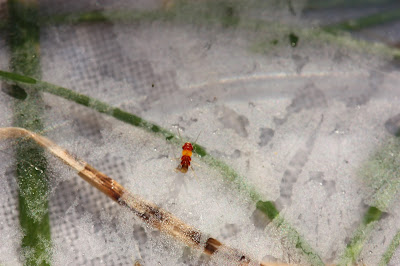Saturday, August 31, 2013
Montana Part II: Perlodid Stonefly "Skwala"
Last Monday we floated -- and fished -- the Upper Clark Fork River, east of Missoula, and I found an important stonefly in this part of the country, the Perlodid stonefly, genus Skwala (probably Skwala americana). The "Skwala hatch" is one of the first major fly fishing events for guides working out of Missoula: it normally happens in April. Most guides focus on the Bitterroot River, but obviously there are Skwalas in other local rivers as well.
This is not a stonefly that's found in the East, so to make this identification I turned to Stewart and Stark's Nymphs of North American Stonefly Genera, pp. 448-451. The critical features for us to see are 1) the pattern on the head, 2) the morphology of the lacinia, and 3) the shape of the mesosternal "Y-arms".
Head: "Head dark with lighter M mark forward of anterior ocellus and incomplete light mesal bar; 2 oval, light occipital spots inside eyes, broken with reticulate dark lines and bordered behind by narrow band of stout spinules." (Stewart and Stark, p. 448) In this photo, we can easily see everything but the band of stout spinules behind each of the spots (though they're easy to see with the microscope).
Lacinia: "Lacinia bidentate with tuft of setae on a low knob below subapical tooth and continuous inner row of marginal setae; complete band of submarginal setae...; terminal tooth about 0.4 times total outer lacinial length and subapical tooth about 0.6 times length of terminal tooth." (p. 448)
Here's what that looks like in a microscope view.
Shape of Y-arms: "Y-arms of mesosternum reach anterior corners of furcal pits." (p. 451) They look like this, as illustrated by Stewart and Stark on p. 450.
I'd note one other feature for confirmation. On the abdomen, the medial longitudinal line consists of a series of dots and slashes --
that feature, too, is illustrated by Stewart and Stark, p. 449. The Perlodid stonefly, Skwala.
Now if I can only get out to Montana in April when these nymphs mature and hatch: it's supposed to be fantastic fishing!
________________
Naturally, I found other insects on Monday as well, some of which require more work for species identification. More on that later, but here are some photos.
1. A "Trico" (family, Leptohyphidae; genus, Tricorythodes). We had prolific hatches of Tricos every morning, no matter where we were fishing.
2. The flatheaded mayfly Nixe, species unknown.
3. A pronggilled mayfly, Paraleptophlebia bicornuta. The "tusks" at the front of the head give this one away.
4. Some small minnow mayflies that I need to ID. (Very small, 4-5 mm)
5. And a very large, very black, common netspinner larva. The genus is Arctopsyche. I think it's A. californica, but I need to look into that further.
Sunday, August 25, 2013
First pictures from Montana, 2013: Grant Creek
One of the virtues of staying where we do in Missoula is that Grant Creek runs through our backyard. So, I get to photograph insects before I head out to the streams to catch those big, beautiful trout.
I'm at a disadvantage -- I have to work on a Windows machine: sure miss my iMac that's sitting at home. That means I don't have the editing software that I normally use, so these photos will look a bit rough. Still, I'd better make a start on these photos and clean them up when I get home.
Some of the insects I found I've identified before -- others require microscope work when I get home. That being said let me show you some of the beautiful insects that live in this tiny creek.
1. Above, a small minnow mayfly, and I'm pretty sure it's one that we see in VA as well, Baetis tricaudatus.
2. The spiny crawler mayfly that I always see at this time of year in Montana, Drunella coloradensis. Comes in lots of different colors.
3. A freeliving caddisfly larva! First one I've ever seen out here. Genus Rhyacophila (there's only one genus): species, unknown. This appears to be R. Grandis Gr. See, http://www.flyfishingentomology.com/PNW%20Caddisflies.htm#Rhyacophila: "Distinguished by two clusters of gills on each side of most abdominal segments. Front 2/3 of the head usually dark and the posterior mostly light in color. Pronotum is usually light with a dark stripe down the middle."
4. Common netspinner, Arctopsyche grandis. Identified this one last year. Neat pix!
5. A Glossosomatid (Saddle-case maker) -- genus and species unknown. Have to work on this one.
6. Flatheaded mayfly, Epeorus for sure, and probably E. deceptivus. More work when I get home. Lots of these nymphs on the rocks.
_______________________
Stay tuned!
Wednesday, August 21, 2013
Montana time
It's a time of year to which I always look forward. I'm off to Missoula early Saturday morning, returning on Friday 8/30. I'll soon be seeing the beautiful spiny crawlers, Drunella coloradensis (in the photo above), and the spectacular Giant stoneflies, Pteronarcys californicus.
And then there's that weird looking spiny that we don't see in the East, Timpanoga hecuba.
We'll be floating the Blackfoot River, which I hope will be looking like this:
but I won't be surprised to see flaming hills from time to time as we did two years ago.
Still, the guides say that the fishing is good, and with luck the bad fires will stay on the other side of the Bitterroot mountains.
Will I be collecting insects for photos? You bet! So, the next entry will probably come from Montana. And there may be a picture or two of an osprey, a common sight on these rivers.
Friday, August 16, 2013
Pteronarcys dorsata: our summer, warm water Giant
I went to the North Fork of the Rivanna this morning, and if you've read blog entries from previous summers you know that I go there for only one reason: to photograph the common netspinner Macrostemum. I had no trouble finding Macrostemum larvae -- but this was the catch of the day. Giant stonefly, Pteronarcys dorsata. I found one last week in the Rivanna at Crofton, but the colors on that one weren't very pronounced. This was a beauty.
While we associate Giant stoneflies with clean, cold, mountain streams and expect to see them -- mature nymphs at least -- in the winter, this is a species that we find in the summer and fall in warm water rivers and streams, rivers like the Rivanna. Let's look at Beaty's ID:
P. dorsata -- frontoclypeus with lateral and somewhat truncate lobes adjacent to antennal pedicels; lateral angles of pronotum produced, anterolateral ones almost hook-like; no lateral projections on abdominal segments; each tergite with anterior and posterior abdominal spots sometimes confluent to give the abdomen a longitudinally striped appearance (3-5 stripes possible). Common and widespread (excluding Slate Belt). Univoltine although BAU data suggests a semivoltine life history with nymphs most abundant from June to October. Associated with Podostemum ceratophyllum (riverweed). ("The Plecoptera of North Carolina," p. 28)
1) From conversations with Steven Beaty, I've concluded that the shape of the frontoclypeal "lobes" is not that important for identification. But, this is what one of them looks like.
2) The lateral angles of the pronotum are indeed "produced" (sticking out, pointed), and there are no lateral projections on the abdominal segments.
3) But what are especially clear on this specimen are the dark spots on the anterior and posterior edges of the tergites that give the appearance of longitudinal bands. I'd say there five dark bands on a yellowish background.
So this Giant does not look at all -- in terms of the colors and patterns -- like the other two species we've found: Pteronarcys biloba (Rapidan River) and Pteronarcys proteus (small mountain streams in Sugar Hollow). Compare.
P. biloba
P. proteus
By the way, the P. dorsata nymphs that I've seen are quite a bit smaller than the cold water Giants of winter. This nymph was 14 mm: mature Giants range from 35-50 mm.
_________________
On the netspinners in the North Fork -- I found lots of those fat, long, green Macrostemums packed away in lumps of pebbles and sand on the bottoms of rocks, while on top of the rocks, crawling around in the gnarled vegetation, there were numerous Hydropsyche rossi. Why does each live where it does? It'd be nice to know.
Macrostemum (they're either M. carolina or M. zebratum)
And a side view revealing the slope of the head. It's a strange looking critter.
A good photo taken last year.
Hydropsyche rossi is a netspinner on which the muscle scars on the side of the head remain level. I.e. they do not move towards the top of the head at the rear as they do on H. venularis.
________________
I also found a few small minnow mayflies. They were all Heterocloeon curiosum.
________________
But this was the prize: the Giant stonefly, Pteronarcys dorsata.
Subscribe to:
Posts (Atom)























































